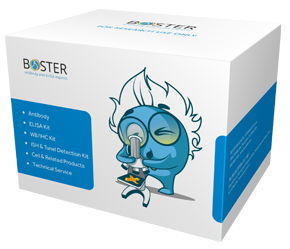Product Info Summary
| SKU: | A05997-1 |
|---|---|
| Size: | 0.1 mg |
| Reactive Species: | Human, Mouse, Rat |
| Host: | Rabbit |
| Application: | ELISA, IF, IHC-P, WB |
Customers Who Bought This Also Bought
Product info
Product Name
Anti-BRSK1 Antibody
SKU/Catalog Number
A05997-1
Size
0.1 mg
Form
Liquid
Description
Boster Bio Anti-BRSK1 Antibody (Catalog # A05997-1). Tested in ELISA, WB, IHC-P, IF applications. This antibody reacts with Human, Mouse, Rat.
Storage & Handling
BRSK1 antibody can be stored at 4°C for three months and -20°C, stable for up to one year. Avoid repeated freeze-thaw cycles. Antibodies should not be exposed to prolonged high temperatures.
Cite This Product
Anti-BRSK1 Antibody (Boster Biological Technology, Pleasanton CA, USA, Catalog # A05997-1)
Host
Rabbit
Contents
BRSK1 Antibody is supplied in PBS containing 0.02% sodium azide.
Clonality
Polyclonal
Isotype
IgG
Immunogen
BRSK1 antibody was raised against a 28 amino acid synthetic peptide from near the carboxy terminus of human BRSK1. The immunogen is located within amino acids 720 - 770 of BRSK1.
*Blocking peptide can be purchased. Costs vary based on immunogen length. Contact us for pricing.
Cross-reactivity
PMEPA1 antibody is human, mouse and rat reactive. At least four isoforms are known to exist; this antibody will detect all of the isoforms.
Reactive Species
A05997-1 is reactive to BRSK1 in Human, Mouse, Rat
Reconstitution
Observed Molecular Weight
68 kDa
Calculated molecular weight
85087 MW
Background of BRSK1
BRSK1 was initially identified as a mammalian homolog to the fission yeast S. pombe Cdr2, a mitosis-regulatory kinase and also shows significant homology to the C. elegans neuronal cell polarity regulator SAD1. BRSK1 is unbiquitously expressed, with highest levels of expression in the brain and testes. Similar to its yeast homolog, BRSK1 is thought to be involved in stress-induced cell cycle arrest. Overexpression of this protein leads to the G2/M arrest in HeLa S2 cells and UV-induced G2/M arrest could be partially abrogated by reduced expression of BRSK1 through the use of siRNA, indicating its role in DNA damage checkpoint function. More recently, it has been shown that both BRSK1 and the related protein BRSK2 are required for mammalian neuronal polarization. While BRSK1- and BRSK2-null mice were viable, double-mutant mice died within two hours of birth. Neurons from these mice showed uniformly-sized neurites as opposed to the normal long axon and multiple shorter dendrites. These neurites also displayed both axonal and dendritic markers. At least two isoforms of BRSK1 are known to exist.
Antibody Validation
Boster validates all antibodies on WB, IHC, ICC, Immunofluorescence, and ELISA with known positive control and negative samples to ensure specificity and high affinity, including thorough antibody incubations.
Application & Images
Applications
A05997-1 is guaranteed for ELISA, IF, IHC-P, WB Boster Guarantee
Assay Dilutions Recommendation
The recommendations below provide a starting point for assay optimization. The actual working concentration varies and should be decided by the user.
BRSK1 antibody can be used for detection of BRSK1 by Western blot at 0.5 - 1 μg/mL. Antibody can also be used for immunohistochemistry starting at 2.5 μg/mL. For immunofluorescence start at 20 μg/mL.
Antibody validated: Western Blot in human samples; Immunohistochemistry in human samples and Immunofluorescence in human samples. All other applications and species not yet tested. Optimal dilutions for each application should be determined by the researcher.
Validation Images & Assay Conditions

Click image to see more details
Western blot analysis of BRSK1 in human brain tissue lysate with BRSK1 antibody at (A) 0.5 and (B) 1 μg/mL.

Click image to see more details
Immunohistochemistry of BRSK1 in human brain tissue with BRSK1 antibody at 2.5 μg/mL.

Click image to see more details
Immunofluorescence of BRSK1 in Human Brain cells with BRSK1 antibody at 20 μg/mL.
Protein Target Info & Infographic
Gene/Protein Information For BRSK1 (Source: Uniprot.org, NCBI)
Gene Name
BRSK1
Full Name
Serine/threonine-protein kinase BRSK1
Weight
85087 MW
Superfamily
protein kinase superfamily
Alternative Names
hSAD1, KIAA1811, SAD1, SADB, Brain-selective kinase 1, SAD1 homolog BRSK1 hSAD1 BR serine/threonine kinase 1 serine/threonine-protein kinase BRSK1|BR serine/threonine-protein kinase 1|SAD1 homolog|SAD1 kinase|brain-selective kinase 1|brain-specific serine/threonine-protein kinase 1|protein kinase SAD1A|serine/threonine-protein kinase SAD-B|synapses of Amphids Defective homolog 1
*If product is indicated to react with multiple species, protein info is based on the gene entry specified above in "Species".For more info on BRSK1, check out the BRSK1 Infographic

We have 30,000+ of these available, one for each gene! Check them out.
In this infographic, you will see the following information for BRSK1: database IDs, superfamily, protein function, synonyms, molecular weight, chromosomal locations, tissues of expression, subcellular locations, post-translational modifications, and related diseases, research areas & pathways. If you want to see more information included, or would like to contribute to it and be acknowledged, please contact [email protected].
Specific Publications For Anti-BRSK1 Antibody (A05997-1)
Hello CJ!
No publications found for A05997-1
*Do you have publications using this product? Share with us and receive a reward. Ask us for more details.
Recommended Resources
Here are featured tools and databases that you might find useful.
- Boster's Pathways Library
- Protein Databases
- Bioscience Research Protocol Resources
- Data Processing & Analysis Software
- Photo Editing Software
- Scientific Literature Resources
- Research Paper Management Tools
- Molecular Biology Software
- Primer Design Tools
- Bioinformatics Tools
- Phylogenetic Tree Analysis
Customer Reviews
Have you used Anti-BRSK1 Antibody?
Submit a review and receive an Amazon gift card.
- $30 for a review with an image
0 Reviews For Anti-BRSK1 Antibody
Customer Q&As
Have a question?
Find answers in Q&As, reviews.
Can't find your answer?
Submit your question




